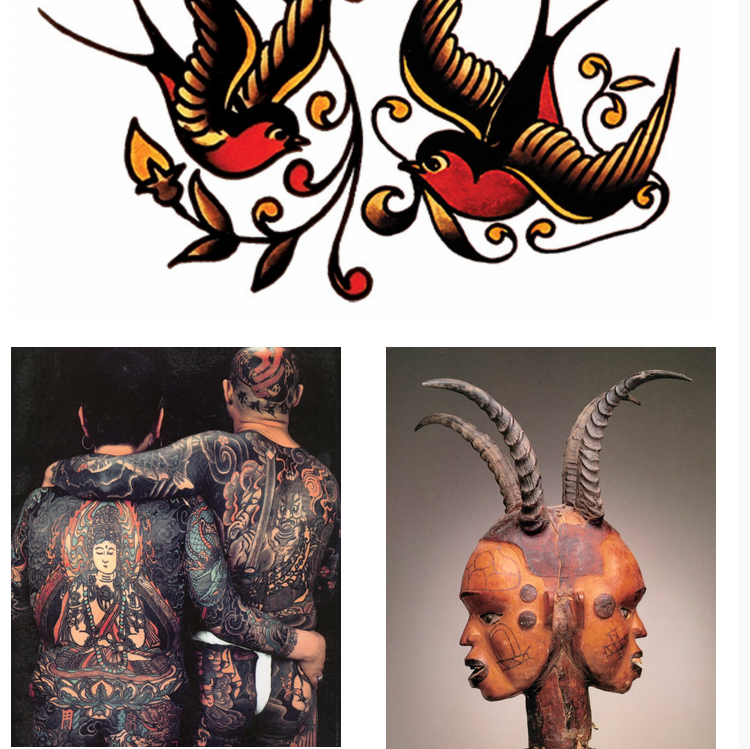Human beings throughout the world mark their skin. The marks can be of a temporary sort, as in body painting, or of a more permanent sort, as in scarification and tattooing. The procedure for tattooing is fairly simple and thus similar worldwide: it consists of pricking the skin beneath the layer that sloughs with a sharp instrument – a thorn, a fish bone, an animal’s tooth – and then inserting into the puncture wounds some color, usually black, provided by soot, the juice of an herb, or ink. The Inuit prefer to sew through the skin with a needle drawing a sooty thread. Whatever the technique, it is a painful ordeal to be tattooed, a fact that points to the great importance of this practice in rites of initiation. Tattooing proves to be a test of one’s endurance and a permanent record, should one be successful, that one has endured; the pain is symbolic of the “death” of an old status making way for the “new being” – the adult, the warrior, the married person. And that new status is as indelible as the tattoos themselves.
North and South American indigenous peoples marked their bodies with tattoos, at least in a limited way, as did the Britons and Thracians of ancient Europe. We find Egyptian mummies still carrying tattooed names of gods. But the highest level of technique and artistic merit in this practice has been reached by a variety of cultures in the islands of the Pacific. Among the Motu Koita of New Guinea, for example, a girl’s life is tracked by tattoos that are even said to “cause” the maturation process (Turner, 271). Traditionally, the Maori men of New Zealand covered their faces with tattooed circles, spirals, and curves. These were the facial marks that particularly fascinated Captain James Cook in the Polynesian journey of 1768; and it was he who gave us the name “tattoo,” from the Tahitian word tattau (“to mark”).
Tattoos are images of the deepest reaches of the human psyche, images with which one’s ego is brought into relationship, for the sake of the necessary feeling that one’s individual identity is meaningful and the feeling that one is deeply connected to the group. It is essential in the tribe that the process of tattooing accompany biological maturation because psychological maturation is required as well. And the Motu Koita have it right: the energy transferred from the depths by archetypal symbols – taken seriously – does in fact “cause” one to put aside childhood and enter into adult living, have the courage to bear children or go to war. These symbols do not work at an intellectual level, however, but only when they are deeply felt or truly “get under one’s skin.”
Turner, Victor. “Bodily Marks.” In The Encyclopedia of Religion, vol. 2. New York, 1987.
Images from the ARAS Archive:
TOP – Swallow tattoos. Commonly sported by American service people, Sailor Jerry tattoos are rich with symbolism. Having a swallow tattoo meant that you had sailed 5000 miles. “They are also associated with the idea of return. This “return” symbolism is rooted in two ideas. The first was the swallow’s famous migration pattern, always returning home to San Juan Capistrano. Second, it was believed that if a sailor dies at sea, birds carry his soul home to heaven.” www.sailorjerry.com
BOTTOM LEFT – 7Nq.001 – Tattooed couple. Mitsuaki Ohwada (Horikin) and Horiyoshi III. Japan, 20th Century.
BOTTOM RIGHT – 8Jf.030 – Janiform Cap Mask with horns. Facial decorations point to the traditional Boki practice of tattooing and are examples of ‘secret writing’ (nsibidi), only vaguely understood today. The forehead circles probably mean ‘love’ in some way, the other marks suggest a ‘leopard’ cult. The black circular keloids at the temples of both heads are also an artistic vestige of an old practice of scarification colored with carbon. Nigeria.

